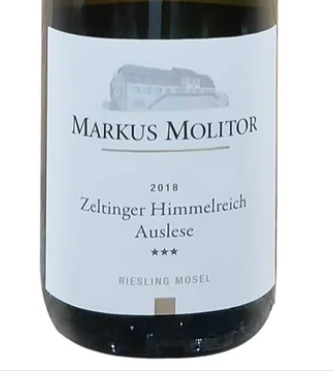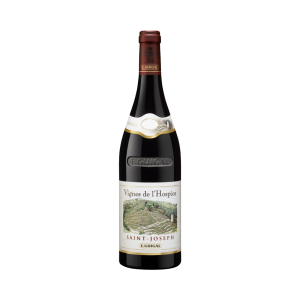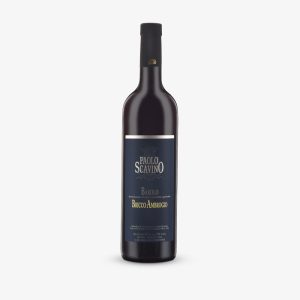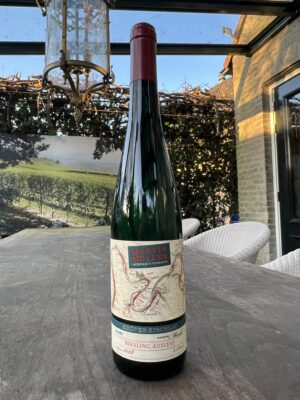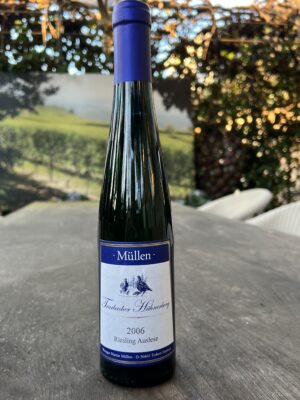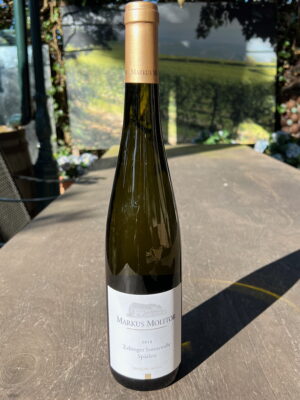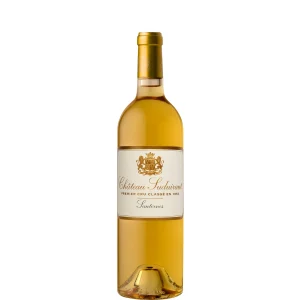With an estate this gargantuan, whose core vineyards stretch along 19 prime miles of the Mosel and encompass several important sites on the Saar, there were bound to have been significant local meteorological differences in 2018, especially as regards summer precipitation or its absence. But Markus Molitor expressed confidence that “if you didn’t have excessive yields, and your vineyards [over the years] regularly enjoy proper care and occasional humus-enrichment, then your vines didn’t suffer.” The rapidity – exceptional even by vintage standards – with which his grapes accumulated both sugar and flavor certainly supports that contention. When I arrived to taste 2017s on September 15, 2018, the estate was just two days removed from commencing its Riesling harvest, and among the first picked were grapes qualifying for designation as “three-star” Auslesen. After that, though, with stable weather and little botrytis, Molitor and his usual huge and experienced crew felt unrushed and on top of the situation. “It was so relaxed [entspannt],” he reported, “for weeks the sort of weather you dream of.”
Paucity of botrytis globally speaking did not signify an absence of nobly sweet wines but only the need for time, skill and determination to select. And what noble botrytis there was – coming as it did on top of healthy shriveling that had already engendered grapes approaching TBA Oechsle levels – resulted in an amazing tally of 7 BAs and 16 Trockenbeerenauslesen. Molitor even harvested in early 2019 three wines from frozen grapes that will probably be released as Eiswein. As usual, though, few of these sweet super-concentrates will hit the market for years, and most were still fermenting – right beside me, in fact – when I visited in late November 2019. (There are, however, significantly fewer “three-star” Auslesen from 2018 than from some other recent vintages.) At the opposite end of the must weight spectrum, Molitor’s 2018 collection is remarkable in its own way. From a vintage of such high aggregate ripeness, in which many growers report having struggled or even failed to pick grapes that they deemed suitable for Kabinett, there are 13 frequently sensational wines so labeled chez Molitor (of varying dryness or sweetness), more than twice as many as in 2017 and two more even than in 2016, a year marked by its abundance of exceptional, alcoholically delicate Molitor bottlings. This vintage 2018 collection will thus go down as unprecedented (“unimaginable” is his choice of superlative) even by Molitor’s frequently record-setting standards, for its sheer stylistic breadth, occupied by so many different bottlings. (There will be more than 90, and perhaps ultimately more than 100 in aggregate.) Total harvest volume also set a record, though that is as much a function of relentless expansion as of nature’s vintage-specific generosity. As for quality, there is the usual elevated overall level (even setting aside the eventual BAs and TBAs) punctuated by stunning high points. Molitor sought to counter any suspicions – including my own – concerning ageworthiness. “Just because the 2018s are so accessible and fruity,” he insisted, “doesn’t mean that they won’t be long-lived,” and he adduced the relevance of never having needed lower levels of SO2 to stabilize his wines than in 2018.
Apropos of “relentless expansion,” the 2018 collection features wines from newly acquired acreage in Erdener Prälat (formerly farmed by Jos. Christoffel Erben); Brauneberger Juffer and Juffer-Sonnenuhr (formerly Wwe Dr. H. Thanisch – Erben Müller-Burggraef); and Thörnicher Ritsch, located 16 meandering miles upstream from any previous Molitor Middle Mosel holdings. In 2020, a significant initial volume of wine will issue from the huge and in large part recently replanted former Saar State Domaine (an acquisition I discussed in introducing my most recent report on the Saar, as well in introducing my coverage of Molitor’s vintage 2016 collection), but Molitor does not intend to bottle site-specific, Prädikat, nor indeed even separately labeled wines from that satellite estate before 2024. I am still awaiting my first taste of a Molitor offering from the famed Bernkasteler Doctor (in which he acquired a small parcel at the end of 2015), auctioned in September two years after harvest. (From 2017, there were two “three-star” Auslesen, one dry-tasting and one near the top end of the sweetness scale, i.e., one with a white chip on its label and one with a gold chip.) In addition to the Doctor wines, the TBAs, all but one BA, the as yet unassembled dry (“white chip”) generic Rieslings (including the Saar and Mosel “Alte Reben”), and upper-level Pinot Blancs from this collection, the following vintage 2018 Molitor releases were also not included in my late November 2019 tasting session: dry-tasting (“white chip”) Graacher Domprobst Spätlese, Erdener Treppchen Kabinett and Spätlese, Zeltinger Schlossberg Spätlese, and “three-star” Auslesen from Wehlener Sonnenuhr and Erdener Prälat; “green chip” “three-star” Auslesen from Saarburger Rausch and Zeltinger Schlossberg; and “gold chip” “three-star” Auslesen from Erdener Treppchen, Zeltinger Schlossberg and Ürziger Würzgarten.
Special note should be taken of the Molitor Pinot Noirs from 2016 (which, following usual practice, were released concurrently with the Rieslings of 2018). I observed when reporting on the corresponding 2014s that those wines seemed to illustrate how a challenging vintage demanding selective picking can often result in wines of greater complexity and refinement than those harvested in a year when high-ripeness and rude good health are assured. Such may well prove to be the case with 2016, and I write this having not yet tasted the two ostensibly top “three-star” bottlings (from Trabener Schlossberg and Graacher Himmelreich), which Molitor was not prepared to show me when I last visited. The paler color and marginally lower alcohol of those I tasted vis-à-vis 2015 correspond with a positive degree of levity on the palate. More significantly, several Molitor vintage 2016 reds evince a savory, carnal dimension and textural allure that are part and parcel of Pinot Noir’s deliciously distinctive potential, but are sometimes covered up or pushed aside at this address by sheer ripeness of fruit flavor, or by the tannins as well as aromatics and flavors of youthful oak.
For a great deal of background on this remarkable grower and his mega-estate, I refer you to the introductions that accompanied my coverage of the 2014s, 2015s, 2016s and 2017s. In each of these instances I have explained in detail Molitor’s unusual labeling conventions, and since (for once!) I am not going to review those here, anyone not already thoroughly familiar with them should consult my most recent update (accompanying coverage of the 2017s) in order to avoid confusion about how Molitor’s wines are identified and what he signifies with his codings: Prädikats, stars and tiny colored patches on the labels that I refer to as “chips.” (Also, bear in mind my own convention:
